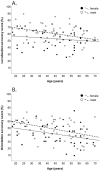Modernising tactile acuity assessment; clinimetrics of semi-automated tests and effects of age, sex and anthropometry on performance
- PMID: 35070517
- PMCID: PMC8759376
- DOI: 10.7717/peerj.12192
Modernising tactile acuity assessment; clinimetrics of semi-automated tests and effects of age, sex and anthropometry on performance
Abstract
Background: Reduced tactile acuity has been observed in several chronic pain conditions and has been proposed as a clinical indicator of somatosensory impairments related to the condition. As some interventions targeting these impairments have resulted in pain reduction, assessing tactile acuity may have significant clinical potential. While two-point discrimination threshold (TPDT) is a popular method of assessing tactile acuity, large measurement error has been observed (impeding responsiveness) and its validity has been questioned. The recently developed semi-automated 'imprint Tactile Acuity Device' (iTAD) may improve tactile acuity assessment, but clinimetric properties of its scores (accuracy score, response time and rate correct score) need further examination.
Aims: Experiment 1: To determine inter-rater reliability and measurement error of TPDT and iTAD assessments. Experiment 2: To determine internal consistencies and floor or ceiling effects of iTAD scores, and investigate effects of age, sex, and anthropometry on performance.
Methods: Experiment 1: To assess inter-rater reliability (ICC(2,1)) and measurement error (coefficient of variation (CoV)), three assessors each performed TPDT and iTAD assessments at the neck in forty healthy participants. Experiment 2: To assess internal consistency (ICC(2,k)) and floor or ceiling effects (skewness z-scores), one hundred healthy participants performed the iTAD's localisation and orientation tests. Balanced for sex, participants were equally divided over five age brackets (18-30, 31-40, 41-50, 51-60 and 61-70). Age, sex, body mass index (BMI) and neck surface area were assessed to examine their direct (using multiple linear regression analysis) and indirect (using sequential mediation analysis) relationship with iTAD scores.
Results: Mean ICC(2,1) was moderate for TPDT (0.70) and moderate-to-good for the various iTAD scores (0.65-0.86). The CoV was 25.3% for TPDT and ranged from 6.1% to 16.5% for iTAD scores. Internal consistency was high for both iTAD accuracy scores (ICC(2,6) = 0.84; ICC(2,4) = 0.86). No overt floor or ceiling effects were detected (all skewness z-scores < 3.29). Accuracy scores were only directly related to age (decreasing with increasing age) and sex (higher for men).
Discussion: Although reliability was similar, iTAD scores demonstrated less measurement error than TPDT indicating a potential for better responsiveness to treatment effects. Further, unlike previously reported for TPDT, iTAD scores appeared independent of anthropometry, which simplifies interpretation. Additionally, the iTAD assesses multiple aspects of tactile processing which may provide a more comprehensive evaluation of tactile acuity. Taken together, the iTAD shows promise in measuring tactile acuity, but patient studies are needed to verify clinical relevance.
Keywords: Chronic pain; Locognosia; Neck; Neurologic examination; Reliability; Tactile acuity; Touch perception.
©2021 Olthof et al.
Conflict of interest statement
G Lorimer Moseley is an Academic Editor for PeerJ. In the last 5 years, G. Lorimer Moseley has received support from: Reality Health, Pfizer Australia, Seqirus, Kaiser Permanente, Workers’ Compensation Boards in Australia, Europe and North America, AIA Australia, the International Olympic Committee, Port Adelaide Football Club and Arsenal Football Club. Professional and scientific bodies have reimbursed him for travel costs related to presentation of research on pain at scientific conferences/symposia. He has received speaker fees for lectures on pain and rehabilitation. NAO, DJC and DSH are exploring opportunities to commercialise the iTAD. All other authors declare no conflict of interest.
Figures




References
-
- Adamczyk WM, Luedtke K, Szikszay TM. Two-point discrimination and the low back pain: not as unreliable as it seems, but what about standardised procedures? Musculoskeletal Science and Practice. 2018;35:e110–e111. - PubMed
LinkOut - more resources
Full Text Sources
Research Materials

